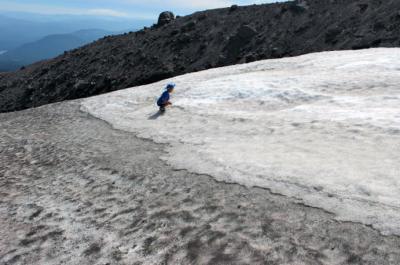The Down and Dirty About North American Snowpack
For the first time over western North America, Pacific Northwest National Laboratory researchers and collaborators used measurements from a recent large-area survey of observed soot (a.k.a. black carbon) in snow to understand their simulated amount and sources in snowpack.
What the team found was a surprise. They expected to find equal skills of the climate model in representing soot in the snowpack and the air over northwestern United States and western Canada. Instead, the observations revealed that soot was more underrepresented in the simulated snowpack than in the atmosphere.
The team hypothesized that this underrepresentation was because the model omits soil as a likely source of black carbon. Exposed soil areas near patches of snowpack in the northwestern United States are subject to soot deposition throughout the year and likely accumulate a substantial reservoir of it. This black carbon-containing soil can mix with the snow, e.g., by livestock or by winds disturbing the soil, lofting and depositing it to snow.
"Our tracking and tagging technique and observational analysis allowed us to evaluate how well a global climate model represents the actual impact and sources of soot on snowpack," said lead researcher Dr. Hailong Wang, atmospheric scientist at PNNL.
The team used the Community Atmosphere Model version 5 (CAM5) with a PNNL-designed source tracking technique to establish black carbon source-receptor relationships between 30 sources worldwide and the two receptor-regions in western North America. They calculated the radiative heating of black carbon in all the receptor regions. The CAM5 simulation was conducted with meteorological fields constrained by a reanalysis dataset for year 2013, when measurements of black carbon in both near-surface air and snow were available for model evaluation. The source attribution of black carbon in snow to different emission sectors was evaluated against observations and statistical methods to reveal potential deficiencies in black carbon emissions used in CAM5.
They found that sources of black carbon, from combustion of fossil fuels (coal, oil, natural gas, petroleum) and biomass/biofuels that are located in the receptor-regions, contribute more to near-surface atmospheric black carbon and deposition than distant sources (e.g., Asian pollution). They found the distant sources to be more important in the middle and upper air. Fossil fuel was the dominant source for total black carbon loading over both northwestern United States and western Canada; it was also the dominant local source type for black carbon in the air and deposition to snow. For all distant source regions combined, though, biomass/biofuel was a larger contributor than fossil fuels.
This particular model-observation study shows the importance of reality checks as models are honed to make the most accurate assessment of climate change and predictions of future conditions.
Scientists know that soot particles are a significant climate warming agent. Imagine the particles as a dark jacket, covering the snow and absorbing the sunlight. The absorption is enough to speed up snowmelt, which may further affect the supply of seasonal fresh water. This is important-particularly in the Pacific Northwest and California, regions that heavily rely on snowpack for fresh water supplies at certain times of the year. Accurately predicting the effects of soot on the Earth system is dependent upon the accuracy of modeling it. Conducting these studies allows identification and comparisons of dominant source regions and types of black carbon in western North America to determine where pollution can be cut back in order to have the largest positive impact on the environment.
Even with a large underrepresentation of soot in snow--such as what was found in this study--model calculations show that the soot-in-snow heating effect is very significant.
Sponsors: The research was supported by the Department of Energy's Office of Science, Office of Biological and Environmental Research for the Earth System Modeling Program, the Environmental Protection Agency's Science to Achieve Results (STAR) program, and the China Scholarship Fund.
User Facilities: Computing experiments used DOE's National Energy Research Scientific Computing Center, a DOE Office of Science user facility, and DOE's EMSL (Environmental Molecular Sciences Laboratory) computing resources located at PNNL.
Research Team: Rudong Zhang, Hailong Wang, Yun Qian, Phil J. Rasch, Po-Lun Ma, PNNL; D.A. Hegg, S.J. Doherty, C. Dang, and Q. Fu, University of Washington.

